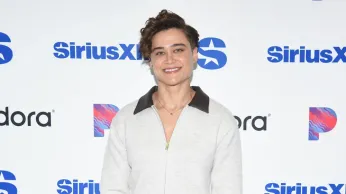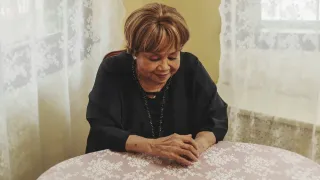
Nov 5
Katy O’Brian Steps Into the Ring: Honoring Queer Icons, Facing Down Stereotypes, and Punching Up Representation in “Christy”
READ TIME: 4 MIN.
The world of boxing isn’t exactly known for its rainbow flags. But in the new biopic “Christy,” queer resilience takes center ring—and Katy O’Brian, herself a queer actor and martial artist, brings both the brawn and the nuance to a story that punches far above the typical sports drama weight class. In a cinematic landscape that too often relegates LGBTQ+ athletes to the sidelines or closet, “Christy” lands a bruising, beautiful combination: the truth about one of America’s greatest boxers, her battles in and out of the ring, and the women who helped her fight for her life and her identity .
For those who missed the ‘90s sports headlines, Christy Martin—brilliantly played here by Sydney Sweeney—became the face of women’s boxing just as the world was waking up to the idea that women could throw punches with the same ferocity (and showmanship) as men . But Martin’s legacy isn’t just about her title belts or her Sports Illustrated covers; it’s about surviving a culture—and a marriage—that wanted to erase her queerness.
Enter Lisa Holewyne, played by O’Brian, an International Women’s Boxing Hall of Famer and, in real life, the woman who would become Martin’s wife years after their time as rivals in the ring . O’Brian’s character is more than a plot device; she’s a symbol of possibility—a reminder that queer love stories can bloom even in the most unexpected (and punch-drunk) places.
“There was nothing between us,” Holewyne insists about their early days sparring together, as recalled by O’Brian. “Christy swears at a party she was flirting with me, but to this day, I don’t believe her” . It’s the kind of honesty—awkward, funny, and real—that LGBTQ+ audiences will instantly recognize. The film doesn’t force a love-at-first-sight narrative, but instead honors the slow, complex, and sometimes messy reality of queer connection.
For O’Brian, whose own career has spanned action franchises ("Mission: Impossible – The Final Reckoning"), queer horror-comedies ("Queens of the Dead"), and now a deeply personal turn in “Christy,” this film is about more than just landing punches. It’s about honoring the women who fought—sometimes literally—to live openly, and about showing LGBTQ+ audiences that our stories don’t end in tragedy or shame . O’Brian’s own background in martial arts and bodybuilding made her a natural fit for the role, but it was her emotional intelligence that brought Lisa Holewyne’s quiet heroism to life.
Behind the scenes, O’Brian describes moments of intense vulnerability, recalling a scene with Sweeney where, after a brutal match, “Sydney gives me this look of, even though on the exterior, she seems ok, that right now, no. And it was so heartbreaking. And the thing we want to do is make sure that person is ok eventually. And it doesn’t have to be right away, but eventually. And so it was just trying to bring that out” . For O’Brian, this wasn’t just acting—it was advocacy.
“Christy” doesn’t shy away from the darkness: From the homophobia at home (a mother who suggests “a priest to cleanse her of gayness”) to the violence of her marriage and the literal fight for survival after her husband’s attempted murder . But what resonates for queer audiences is the film’s refusal to reduce Martin to a victim. She’s complicated, sometimes messy, often inspiring—a closeted lesbian who didn’t ask to be a feminist icon, but became one anyway.
For LGBTQ+ viewers, the film’s emotional gut-punch is seeing a queer narrative that doesn’t end with loss or erasure, but with survival, championship, and, eventually, love. The story moves beyond coming out, exploring the ongoing battle for authenticity—both in the public eye and behind closed doors. It’s a reminder that queer lives are never just footnotes to someone else’s story.
O’Brian’s performance—and the film as a whole—lands at a moment when LGBTQ+ athletes are finally starting to be recognized for their full humanity, not just their headlines. “Christy” is a love letter to the underdogs who’ve been told to play it straight, to the queer kids who find liberation in sweat and bruises, and to the icons who fought so that the next generation could see themselves reflected—blood, sweat, mascara, and all—on the big screen .
As O’Brian puts it, “We wanted to make sure that in those initial scenes, there’s just nothing there. At one point, said, ‘Christy swears at a party she was flirting with me, but to this day, I don’t believe her.’” . It’s a wink to the audience: Sometimes queer love takes time, sometimes the ring is the only safe place, and sometimes the bravest thing you can do is step forward, fists up, and claim your own story.
With “Christy,” Katy O’Brian and Sydney Sweeney aren’t just making a sports movie. They’re sparring with the past, honoring those who fought before, and proving that queer stories—and queer icons—are here to stay, gloves on and hearts wide open.






